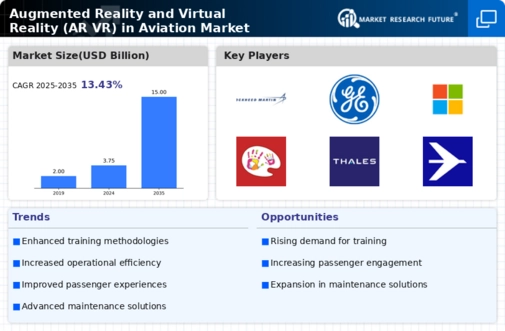Enhanced Safety Protocols
The Augmented Reality and Virtual Reality (AR VR) in Aviation Market is increasingly leveraging AR VR technologies to bolster safety protocols across various aviation operations. By employing AR systems, airlines can provide real-time safety information and training to crew members, ensuring they are well-prepared for emergencies. For instance, VR simulations can recreate emergency scenarios, allowing crew members to practice their responses in a controlled environment. This proactive approach to safety training is supported by data showing that airlines utilizing AR VR technologies report a 15% improvement in safety compliance rates. Furthermore, AR applications can assist maintenance teams by highlighting potential safety hazards during inspections, thereby reducing the risk of accidents. As safety remains a paramount concern in aviation, the integration of AR VR technologies is likely to play a crucial role in enhancing overall operational safety.
Enhanced Training Solutions
The Augmented Reality and Virtual Reality (AR VR) in Aviation Market is experiencing a transformative shift in training methodologies. By integrating AR and VR technologies, aviation training programs are becoming more immersive and effective. For instance, pilots can engage in realistic flight simulations that replicate various scenarios, enhancing their decision-making skills. According to recent data, the adoption of AR VR in pilot training has led to a 30% reduction in training time, allowing airlines to optimize their resources. Furthermore, maintenance personnel benefit from AR applications that provide real-time data overlays, improving their efficiency and accuracy during inspections. This trend indicates a growing recognition of AR VR as a vital tool in aviation training, potentially reshaping how future aviation professionals are prepared for their roles.
Improved Maintenance Procedures
In the Augmented Reality and Virtual Reality (AR VR) in Aviation Market, maintenance procedures are undergoing significant enhancements through the application of AR technologies. Technicians can utilize AR headsets to visualize complex aircraft systems, overlaying digital information onto physical components. This capability not only streamlines the maintenance process but also reduces the likelihood of errors. Data suggests that AR-assisted maintenance can decrease aircraft downtime by up to 25%, which is crucial for airlines aiming to maximize operational efficiency. Moreover, the ability to access real-time data and instructional overlays during maintenance tasks empowers technicians to perform their duties with greater confidence and precision. As the aviation sector continues to prioritize safety and efficiency, the integration of AR VR technologies in maintenance is likely to become a standard practice.
Interactive Passenger Experiences
The Augmented Reality and Virtual Reality (AR VR) in Aviation Market is increasingly focusing on enhancing passenger experiences through interactive technologies. Airlines are exploring AR applications that allow passengers to engage with their surroundings in novel ways, such as virtual tours of the aircraft or interactive entertainment options during flights. This trend is supported by data indicating that 70% of travelers express interest in using AR applications while flying. By providing immersive experiences, airlines can differentiate themselves in a competitive market, potentially increasing customer satisfaction and loyalty. Furthermore, the integration of AR VR technologies can facilitate better communication of safety procedures, making them more engaging and memorable for passengers. As the demand for unique travel experiences grows, the role of AR VR in aviation is expected to expand significantly.
Cost Reduction in Training and Operations
The Augmented Reality and Virtual Reality (AR VR) in Aviation Market is poised to deliver substantial cost reductions in both training and operational processes. By utilizing AR VR technologies, airlines can minimize the expenses associated with traditional training methods, which often require extensive resources and time. For example, the implementation of VR simulations for pilot training can lead to a reduction in fuel costs and aircraft wear and tear, as training can be conducted in a virtual environment. Additionally, AR applications can assist in maintenance tasks, reducing the need for physical parts and tools, thereby lowering operational costs. Data indicates that airlines adopting AR VR solutions may achieve up to a 20% decrease in overall training and operational expenses. This financial incentive is likely to drive further investment in AR VR technologies within the aviation sector.

















Leave a Comment